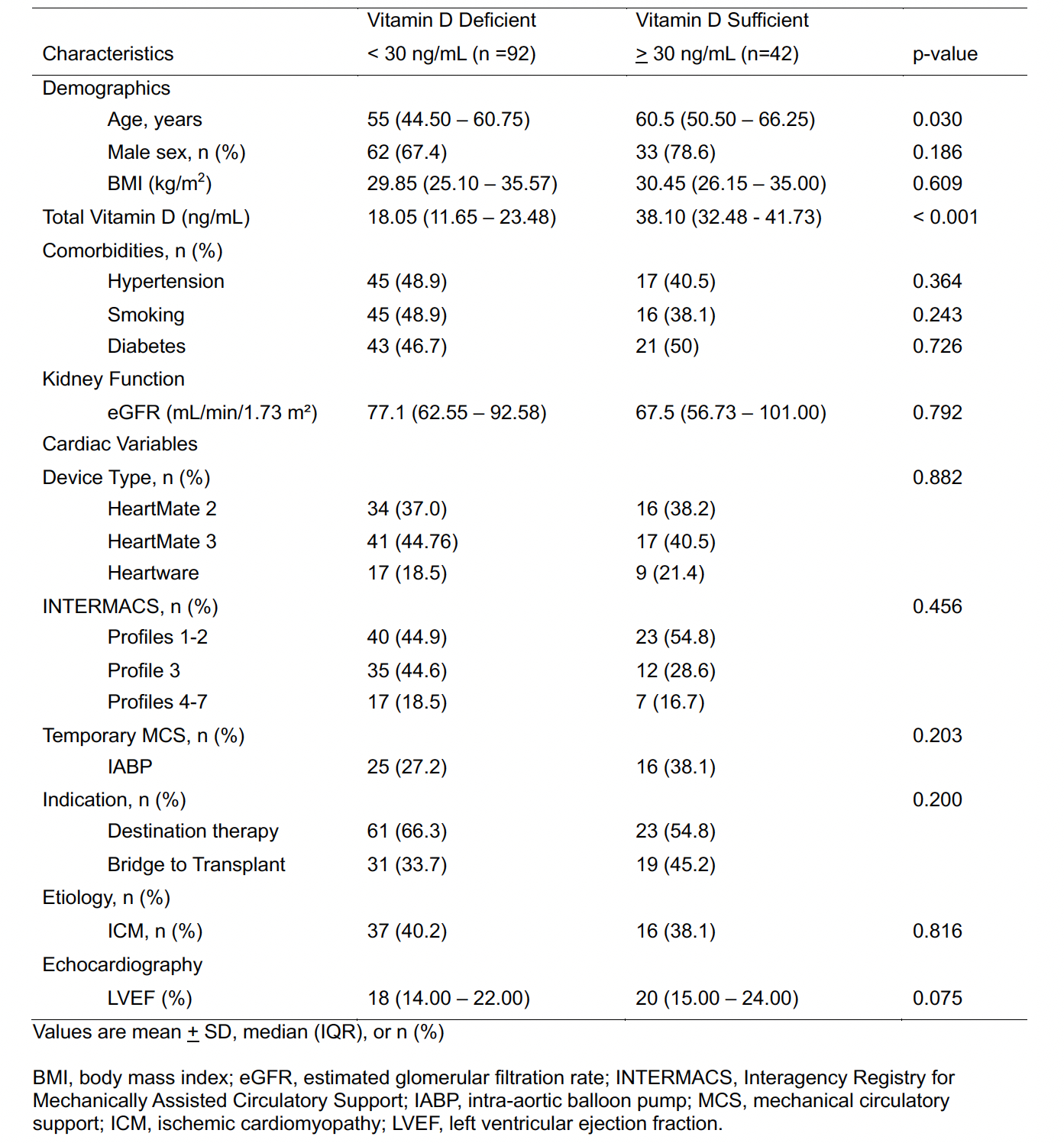Final ID: MDP245
The Impact of Vitamin D Status on Driveline Infections and Cerebral Vascular Accidents in Patients Undergoing Left Ventricular Assist Device Implantation
Abstract Body (Do not enter title and authors here): Introduction:
Left ventricular assist devices (LVADs) have become an increasingly common treatment option for patients with advanced heart failure, serving as either a bridge to transplantation or destination therapy. Despite major advancements in the field of mechanical circulatory support, cerebral vascular accidents (CVA) and driveline infections (DLI) continue to have a detrimental impact on morbidity and mortality.
Research Question:
Is there a higher incidence of DLI and CVA in vitamin D deficient patients that are undergoing LVAD implantation?
Goals/Aims:
We aimed to evaluate vitamin D deficiency as a potential risk factor for DLI and CVA in patients undergoing LVAD implantation.
Methods:
We performed a retrospective chart review of patients that underwent LVAD implantation at our institution from 2010 to 2022. Patients with vitamin D levels measured within 90 days of implantation were classified into either vitamin D sufficient (>30 ng/ml) or deficient (<30 ng/ml). The Kaplan-Meier method estimated 18-month freedom of DLI and CVA. The Cox proportional hazards model estimated the effect of deficiency on DLI/CVA risk. Baseline characteristics were recorded (table 1), and a multivariate cox model corrected for differences. Patients who were transplanted or expired were censored at their last clinic visit.
Results:
The study included 134 patients (mean age 53 +/- 13.23, 71.8% male), with 92 in the deficient group and 42 in the sufficient group. During the study period, 36 patients (27.5%) underwent transplant or expired, and there were 32 DLI and 7 CVA events. DLI-free survival was significantly higher in the sufficient group (90.5% vs. 69.6%, log rank p = 0.014). Patients in the sufficient group were found to be significantly older, but no other significant differences were found (Table 1). The unadjusted and age-adjusted hazard ratios for DLI were 3.430 (95% CI: 1.203 – 9.782, p = 0.021) and 3.190 (95% CI: 1.111 – 9.160, p = 0.031) respectively. No difference in CVA incidence was observed.
Conclusion:
Our findings support vitamin D deficiency as a potential modifiable risk factor for DLI, warranting further research to establish causality and assess the impact of vitamin D repletion on infection rates. Vitamin D levels did not appear to influence CVA incidence.
Left ventricular assist devices (LVADs) have become an increasingly common treatment option for patients with advanced heart failure, serving as either a bridge to transplantation or destination therapy. Despite major advancements in the field of mechanical circulatory support, cerebral vascular accidents (CVA) and driveline infections (DLI) continue to have a detrimental impact on morbidity and mortality.
Research Question:
Is there a higher incidence of DLI and CVA in vitamin D deficient patients that are undergoing LVAD implantation?
Goals/Aims:
We aimed to evaluate vitamin D deficiency as a potential risk factor for DLI and CVA in patients undergoing LVAD implantation.
Methods:
We performed a retrospective chart review of patients that underwent LVAD implantation at our institution from 2010 to 2022. Patients with vitamin D levels measured within 90 days of implantation were classified into either vitamin D sufficient (>30 ng/ml) or deficient (<30 ng/ml). The Kaplan-Meier method estimated 18-month freedom of DLI and CVA. The Cox proportional hazards model estimated the effect of deficiency on DLI/CVA risk. Baseline characteristics were recorded (table 1), and a multivariate cox model corrected for differences. Patients who were transplanted or expired were censored at their last clinic visit.
Results:
The study included 134 patients (mean age 53 +/- 13.23, 71.8% male), with 92 in the deficient group and 42 in the sufficient group. During the study period, 36 patients (27.5%) underwent transplant or expired, and there were 32 DLI and 7 CVA events. DLI-free survival was significantly higher in the sufficient group (90.5% vs. 69.6%, log rank p = 0.014). Patients in the sufficient group were found to be significantly older, but no other significant differences were found (Table 1). The unadjusted and age-adjusted hazard ratios for DLI were 3.430 (95% CI: 1.203 – 9.782, p = 0.021) and 3.190 (95% CI: 1.111 – 9.160, p = 0.031) respectively. No difference in CVA incidence was observed.
Conclusion:
Our findings support vitamin D deficiency as a potential modifiable risk factor for DLI, warranting further research to establish causality and assess the impact of vitamin D repletion on infection rates. Vitamin D levels did not appear to influence CVA incidence.
More abstracts on this topic:
A Rare Case of Purulent Methicillin-Resistant Staphylococcus Aureus Pericarditis Presenting with Septic Shock
Elisarraras Francisco, Roberts Jacob, Hindosh Ziad, Arega Enat, Madnick David, Cruz Daniel, Srivastava Pratyaksh
Catastrophic Bioprosthetic Aortic Valve Thrombosis: An Unappreciated Complication of Veno-Arterial Extracorporeal Membrane Oxygenation Support in Cardiogenic ShockO'hara Patrick, Heid Christopher, Lahsaei Peiman, Farr Maryjane, Garg Sonia, Araj Faris, Truby Lauren, Goral Montana, Kim Han, Malensek Paris, Beaini Hadi, Patel Ravi, Jawaid Anas, Hussain Fizza

